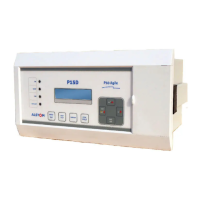2 MONITORING & CONTROL
2.1 Monitoring Functions (Event, Fault, Disturbance Record)
The IED logs three different types of record. These are Event, Fault and Disturbance records, which
are stored in the IEDs non-volatile memory. It is important to log records because this allows you to
establish the sequence of events that occurred, for example following a particular power system
condition.
The device is capable of storing up to:
• 100 event records
• 5 Fault records
• 5 Disturbance records
When the available space is exhausted, the oldest record is automatically overwritten by the new one.
The IEDs internal clock provides a time tag for each event, to a resolution of 1 ms.
The VIEW RECORDS column contains details of these Event and Fault records, which can be
displayed on the IEDs front panel, although it is easier to view them using the settings application
software.
The device supports IEC 60870-5-103 and Modbus protocol. It auto-detects IEC-60870-5-103 and
MODBUS command and responds in respective language. There is no any specific setting which
defines the protocol.
Note: The MODBUS by design does not support event functionality.
2.1.1 Event Records
Event records are generated when certain events happen. A change in any digital input signal or
protection element output signal causes an event record to be created. These events are generated
by the protection software and immediately time stamped. They are then transferred to non-volatile
memory for storage.
The device continuously monitors logical and physical status. There are three physical Binary inputs
provided, marked as S1, S2 and S3. The S1 is designed to monitor breaker status and also use this
status for Cold load operation, while S2 and S3 are general purpose. Any physical or logical change is
recorded as event. These events are stored in internal, non-volatile memory along with a time stamp.
Some of the events recorded include: Protection pickup, Relay Reset and CB Trip. A complete list can
be found in protocol document. Up to 100 such events can be stored and downloaded for detailed
analysis. Details of event data are as follows:
Capacity: 100 events
Time-tag: 1 millisecond
Triggers: Any selected protection alarm and threshold, Logic input change of state, Self-test
events and setting changes.
The user can view the event records either using the front panel interface, the USB port or remotely
using the rear EIA(RS)485 port.

